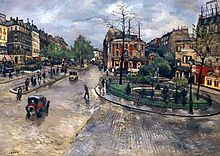Marcel Leprin


Marcel François Leprin (born February 12, 1891 in Cannes , † January 27, 1933 in Paris ) was a French painter.
Life and works
Leprin grew up as an orphan in a Don Bosco Salesian institution in Marseille or was raised by an uncle. As a teenager he was a cabin boy on a sailing ship, then worked as a bullfighter in Barcelona and tried to earn a living in a wide variety of professions in Marseille. There he decorated, among other things, some salons in the harbor district with his own paintings, so that he taught himself the painting techniques himself. In 1914 he met his wife Helene, who separated from him in 1919. He came to Paris in 1921 after the First World War , in which he was obliged to do military service, where he worked as a portrait and decoration painter. With the very first work he exhibited at the Salon d'Automne in Paris, he was accepted as a member of the Société du Salon d'Automne .
Finally, the locksmith Achille Depoilly discovered him destitute and homeless on the Place du Tertre . Depoilly, who was on his way to the Mère Cathérine bistro , took him there and bought him a meal. He learned that, after his friends André and Mathieu Verdilhan had told him about life on Montmartre , Leprin had decided to settle there too, but now had no more money. According to a report by Jean Vertex, the painter André Utter happened to have his dinner that evening in the same restaurant and overheard the story. He arranged for a fundraiser for Leprin, found him a place to stay and left him painting utensils.
Leprin led a life as a freelance artist who sold his works to tourists. From 1924 he had an exclusive contract with the frame maker Henri Bureau, who sold his pictures. In 1926 he took a trip through France, on which numerous landscapes and pictures of localities were created. In 1928 and 1931 he had two exhibitions in the Galerie Druet. Despite the successes that were achieved, he fell victim to alcohol and drug addiction. There are reports that he fired shots in Utter's studio and set himself on fire in the street.
About 700 pictures of lepers are known. The paintings from his early phase in Marseille are mostly large-format and decorative, those from the time on Montmartre are rather dark and tailored to the trade, the pictures from his travel time appear warmer and more artistic. They are reminiscent of paintings by Sisley and Pissarro . The Thieme / Becker also notes influences from Adolphe Monticelli , Eugène Delacroix , Édouard Manet , Daumier , Vincent van Gogh and Pierre-Auguste Renoir as well as Paul Cézanne .
Leprin's works can be found in the Petit Palais in Geneva as well as in the Musée d'art moderne de la Ville de Paris, in the Musée Carnavalet and in the Musée de Montmartre .
Exhibitions (selection)
- Paris Autumn Salon 1923.
- December 1964 to January 1965: Marcel Leprin et ses amis Musée Galliéra, Paris.
- March to April 1972: Rétrospective Marcel Leprin Palais de la Méditerranée, Nice.
literature
- Leprin, Marcel . In: Hans Vollmer (Hrsg.): General lexicon of fine artists from antiquity to the present . Founded by Ulrich Thieme and Felix Becker . tape 23 : Leitenstorfer – Mander . EA Seemann, Leipzig 1929, p. 106 .
- Marcel Leprin . In: Hans Vollmer (Hrsg.): General Lexicon of Fine Artists of the XX. Century. tape 3 : K-P . EA Seemann, Leipzig 1956, p. 214 .
- Marcel Leprin, 1891–1933 et ses amis: exhibition Musée Galliéra: décembre 1964 – January 1965 . Musée Galliéra, Paris 1964, OCLC 84299623 .
Web links
- Literature by and about Marcel Leprin in the bibliographic database WorldCat
Individual evidence
- ↑ a b c Philip Lee: Marcel Leprin. Haunted genius of Montmartre on wordpress.com
- ↑ a b c Marcel Leprin (1891–1933) on artexpertswebsite.com
- ↑ Marcel Leprin - Expertise Marc Ottavi. ( expertise-ottavi.com ).
- ↑ Leprin, Marcel . In: Raymond Nacenta (ed.): School of Paris: the painters and the artistic climate of Paris since 1910 . Greenwich, Conn .: New York Graphic Society, 1960, pp. 327 ( n320 - Internet Archive ).
- ^ Revue Bleue, politique et littéraire . Paris 1863, p. 817 ( Textarchiv - Internet Archive ).
| personal data | |
|---|---|
| SURNAME | Leprin, Marcel |
| ALTERNATIVE NAMES | Leprin, Marcel François |
| BRIEF DESCRIPTION | French painter |
| DATE OF BIRTH | February 12, 1891 |
| PLACE OF BIRTH | Cannes |
| DATE OF DEATH | January 27, 1933 |
| Place of death | Paris |
